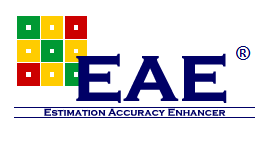
EAE®: Determine Performance-Based Estimation Accuracy
Estimators typically work with an average performance of the cost codes over time. However, using averages of data without considering the range and statistical outliers skews the results. To use the available data correctly, factors such as geography, cost code mix, allowance for pre-assembly, and type of construction need to be considered to make confident decisions based on more than just averages.
Good estimators do this intuitively. EAE® allows jobs to be identified according to a number of criteria. Jobs are selected based on relevant criteria (size, type of work, crew, etc.) An analysis of the estimate vs. final performance can be made in terms of hours or cost, including the following:

Connection to JPAC® and SIS®
The analysis of data for estimation accuracy can be enhanced by improving the quality of the data. The data analysis is only as good as the data upon which it is based. The closer the measurement is to the actual work, the more useful it will be as input to the estimation process.
JPAC® measures labor productivity, and provides feedback from the field on a regular basis of Construction Put in Place (CPIP). JPAC® can provide invaluable information to estimation about the actual installation efforts. Using trend monitoring, estimators can review what impacted the job at various points and take those impacts into account for a similar estimate. Learn more about JPAC® here.
SIS® measures the obstacles that hamper the field’s short interval scheduling. These causes for productivity loss could become magnified in the view of JPAC®, and can also be useful for estimation to understand what daily obstacles should be considered on similar jobs. Learn more about SIS® here.
Please feel free to email (info@mca.net) or call us at (810) 232-9797 to discuss how we may be of service to your chapter or if you would like more information on the services we offer.

